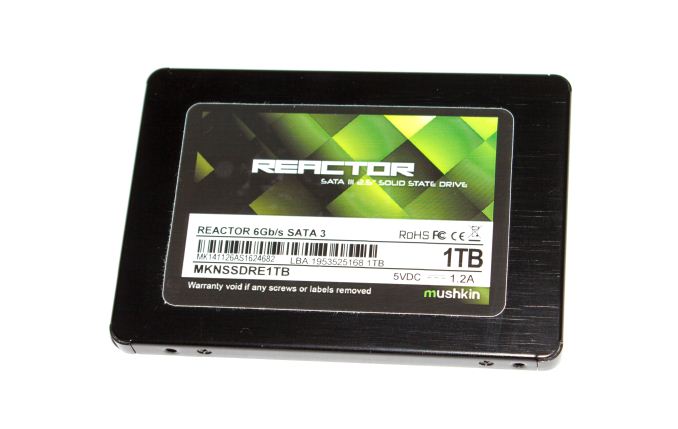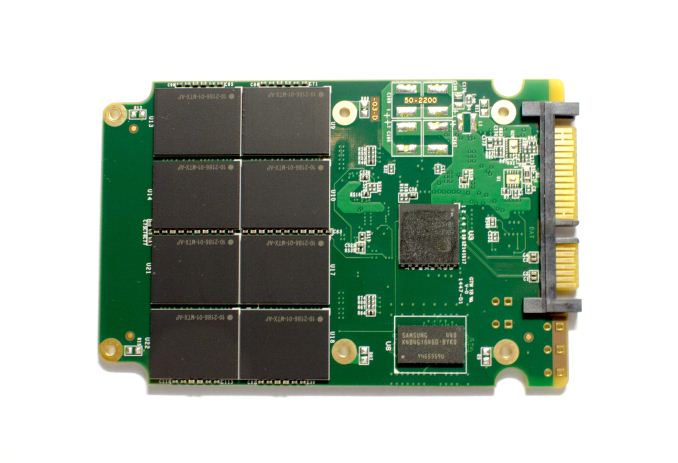Mushkin Reactor 1TB SSD Review
by Kristian Vättö on February 9, 2015 11:32 AM EST- Posted in
- Storage
- SSDs
- Mushkin
- Silicon Motion
- SM2246EN
- Reactor
- Micron 16nm

Silicon Motion has practically become the new SandForce. Almost every tier three manufacturer (i.e. one with no controller/firmware IP or NAND fab) has released an SM2246EN based drive in the past ten months and recently Silicon Motion scored two major tier one partners (namely Micron/Crucial and SanDisk) as well. To be honest, this hasn't come as a surprise because the SM2246EN is a really solid controller with good performance and more importantly it's been mostly issue free (which is something that cannot be said about SandForce).
Mushkin's Reactor combines the SM2246EN with Micron's latest 128Gbit 16nm MLC NAND, and this is actually the first time I've encountered a non-Micron/Crucial SSD with Micron's 16nm NAND. That really emphasizes the benefit NAND manufacturers have because Micron has been using 16nm NAND in its own SSDs for over six months now, but the company hasn't begun shipping it to others in volume until now. I suspect the volumes are still fairly low because the Reactor only comes in 1TB capacity, which is still fairly expensive and thus limits the demand to a level that is easier to manage compared to the more popular 256GB and 512GB models. I was told that 256GB and 512GB models may follow later, but as of now Mushkin will only be offering the Reactor in 1TB.
| Mushkin Reactor Specifications | |
| Capacity | 1TB |
| Controller | Silicon Motion SM2246EN |
| NAND | Micron 128Gbit 16nm MLC |
| Sequential Read | 560MB/s |
| Sequential Write | 460MB/s |
| 4KB Random Read | 74K IOPS |
| 4KB Random Write | 76K IOPS |
| Encryption | N/A |
| Endurance | 144TB |
| Warranty | Three years |
In terms of features the Reactor is a fairly typical value drive without any special features. Neither hardware accelerated encryption nor DevSleep is supported, although the Reactor does support slumber power states for low idle power consumption. Endurance is a respectable 144TB, which translates to 131GB of writes per day for three years.
Moreover, the retail package doesn't include anything in addition to the drive itself and Mushkin offers no software/toolbox for its SSDs.
There are sixteen NAND packages on the PCB with eight on each side. Since we are dealing with a 128Gbit (16GB) die, that translates to four dies per package. Mushkin actually does the packaging in-house (i.e. buys NAND in wafers and then does the binning and packaging), which is why the packages lack the typical Micron logo and labels.
Test Systems
For AnandTech Storage Benches, performance consistency, random and sequential performance, performance vs. transfer size, and load power consumption we use the following system:
| CPU | Intel Core i5-2500K running at 3.3GHz (Turbo & EIST enabled) |
| Motherboard | ASRock Z68 Pro3 |
| Chipset | Intel Z68 |
| Chipset Drivers | Intel 9.1.1.1015 + Intel RST 10.2 |
| Memory | G.Skill RipjawsX DDR3-1600 4 x 8GB (9-9-9-24) |
| Video Card | Palit GeForce GTX 770 JetStream 2GB GDDR5 (1150MHz core clock; 3505MHz GDDR5 effective) |
| Video Drivers | NVIDIA GeForce 332.21 WHQL |
| Desktop Resolution | 1920 x 1080 |
| OS | Windows 7 x64 |
Thanks to G.Skill for the RipjawsX 32GB DDR3 DRAM kit
For slumber power testing we used a different system:
| CPU | Intel Core i7-4770K running at 3.3GHz (Turbo & EIST enabled, C-states disabled) |
| Motherboard | ASUS Z87 Deluxe (BIOS 1707) |
| Chipset | Intel Z87 |
| Chipset Drivers | Intel 9.4.0.1026 + Intel RST 12.9 |
| Memory | Corsair Vengeance DDR3-1866 2x8GB (9-10-9-27 2T) |
| Graphics | Intel HD Graphics 4600 |
| Graphics Drivers | 15.33.8.64.3345 |
| Desktop Resolution | 1920 x 1080 |
| OS | Windows 7 x64 |
- Thanks to Intel for the Core i7-4770K CPU
- Thanks to ASUS for the Z87 Deluxe motherboard
- Thanks to Corsair for the Vengeance 16GB DDR3-1866 DRAM kit, RM750 power supply, Hydro H60 CPU cooler and Carbide 330R case











69 Comments
View All Comments
prime2515103 - Monday, February 9, 2015 - link
Is it just me or are SSD review getting really boring? Every time I see a new one I think, "Maybe something new and exciting this time..." but it never happens. I think SATA needs to be put to rest.piroroadkill - Monday, February 9, 2015 - link
Yeah, SATA3 is making everything boring as hell now.ddriver - Monday, February 9, 2015 - link
That's a limiting factor only on sequential access. There is still huge potential to be harnessed for random access, but nobody seems to be in a hurry to boost IOPS.Kristian Vättö - Monday, February 9, 2015 - link
SATA, or more accurately AHCI, is the limit when it comes to IOPS/latency.cm2187 - Friday, February 13, 2015 - link
I can only talk for myself but personally I could use more size than speed. There is very little of what I do that would give me a different experience at twice the speed of the current SSD specs. But give me a 4TB SSD as cheap as 6TB HDD are today and now I can replace all these spinning disks.0ldman79 - Wednesday, March 4, 2015 - link
Agreed.I might keep a couple of mechanical drives, but I'd love for the price to be closer to the mechanical drives for the capacity.
Too bad that's not the way our market works in much of anything these days.
Solandri - Monday, February 9, 2015 - link
PCIe actually doesn't make that big a difference. Your perception of how fast/slow things are is in terms of seconds you have to wait. These benchmarks are in MB/s which is the inverse of your perception. If you plot these benchmarks correctly in sec/MB, all these SSDs are pretty much the same, and the PCIe SSDs only give you a small fraction of the speedup you got going from SATA2 to SATA3. e.g. Imagine you need to read 1000 MB.10 sec = 100 MB/s HDD
4 sec = 250 MB/s SATA2 SSD (6 sec improvement)
2 sec = 500 MB/s SATA 3 SSD (2 sec improvement)
1.25 sec = 800 MB/s PCIe SSD (0.75 sec improvement)
nathanddrews - Monday, February 9, 2015 - link
This is very true, but doesn't make me want it less. :-DWhat kills me is the lack of "affordable" 2TB+ drives. How is that we go from $400 for 1TB in a 2.5" drive to $1,500-$4,000 for 2TB? I expected that all these die shrinks and 3D technologies would have made 2TB+ SSDs possible in the ~$700-$900 space, but there's nothing to buy! FFS, what gives?
DanNeely - Monday, February 9, 2015 - link
It's a giant game of chicken, and no one wants to be the first to kick over the enterprisy pricing gravy train. We saw the same thing a few years ago when 512TB drives started at $350 but the cheapest 1TB ones were well north of $1k.At the risk of sounding overly cynical; I suspect the first vendor to blink will be whoever is first to either get the higher nand density or the 32 chip controller needed to make a 4TB flash drive in a 2.5" form factor.
Cogman - Monday, February 9, 2015 - link
Mostly it comes down to demand. Nobody is really demanding 2TB SSD drives. As a result, there is little competition and little incentive to make a $800 drive (even though it is totally feasible).